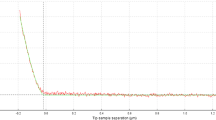Abstract
Fibroblast is a crucial kind of cell in the construction of the tissue engineered dermal equivalent. In order to optimize the cryopreservation protocols of the tissue-engineered dermis, the characteristics of dermal fibroblast in subzero temperatures are required, which include the water permeability of the cell membrane and the apparent activation energy. Using the differential scanning calorimeter (DSC), the volumetric shrinkage during freezing of human dermal fibroblast suspensions was obtained at the cooling rate of 5°C·min−1 in the presence of extracellular ice. To ensure the presence of extracellular ice, a small quantity of ice nucleation bacteria (INA bacteria), pseudomonas syringae was added in the samples. And based on the Karlsson’s model, a nonlinear-least-squares curve fitting technique was implemented to calculate the cryogenic parameters. At the reference temperature T R(=0°C), the water permeability of membrane L pg=0.578 μm·min−1·atm−1 and the apparent activation energy, E LP=308.8 kJ·mol−1. These parameters were then used to simulate water transport of fibroblast during constant cooling at rates between 0.01–50°C · min−1. The simulation results were analyzed to predict the amount of water left in the cell after dehydration and the “optimal cooling rate” for fibroblast cryopreservation. For the dermal fibroblast with DMEM solution, a cooling rate of 4.6°C · min−1 was optimal.
Similar content being viewed by others
References
Yang, Z. M., Tissue Engineering—Basic Research & Clinical Practice (in Chinese), Chengdu: Sichuan Science & Technology Press, 2000.
Gary, B., DSC measurement of cell suspensions during successive freezing runs: implications for the mechanisms of intracellular ice formation. Cryobiology, 1995, 32: 114–128.
Ramachandra, V. D. R., John, C. B., Measurement of water transport during freezing in cell suspensions using a differential scanning calorimeter, Cryobiology, 1998, 36: 124–155.
Mazur, P., Kinetics of water loss from cells at subzero temperatures and the likelihood of intracellular freezing, J. Gen. Physiol., 1963, 47: 347–369.
Levin, R. L., Cravalho, E. G., Huggins, C. G., A membrane model describing the effect of temperature on the water conductivity of erythrocyte membranes at subzero temperatures. Cryobiology 1976, 13: 415–429.
Karlsson, J. O., Cravalho, E. G., Borel, R. I. et al., Nucleation and growth of ice crystals inside cultured hepatocytes during freezing in the presence of dimethylsulfoxide, Biophys. J., 1993, 65: 2524–2536.
Ramachandra, V. D., David, J. S., Kenneth, P. R. et al., Subzero water permeability parameters of mouse spermatozoa in the presence of extracellular ice and cryoprotective agents, Biology of Refrigeration, 1999, 61: 746–775.
Ramachandra, V. D. R., John, C. B., Measurement of water transport during freezing in cell suspensions using a differential scanning calorimeter. Cryobiology 1998, 36: 124–155.
Ramachandra, V. D., Paul, R. B., Kenneth, B. et al., Liver freezing response of the freeze-tolerant wood frog, Rana Sylvatica, in the presence and absence of glucose, I: Experimental Measurements, Cryobiology, 1999, 38: 310–326.
Wang, X., Hua, T. C., Yang, G. H., et al., A primary study on the water osmotic characteristics of fibroblasts employed in tissue engineered dermal replacement, Chinese Journal of Cell Biology, 2004, 26(3): 301–304.
Hua, T. C., Ren, H. S., Cryobiomedical Techniques (in Chinese), Beijing: Science Press, 1994.
Mazur, P., Equilibrium, quasi-equilibrium, and nonequilibrium freezing of mammalian embryos, Cell Biophys, 1990, 17: 53–92.
Author information
Authors and Affiliations
Corresponding author
Rights and permissions
About this article
Cite this article
Wang, X., Cheng, Q., Gao, C. et al. Water permeability parameters of dermal fibroblast employed in tissue engineering in subzero temperatures. Sci. China Ser. E-Technol. Sci. 48, 530–537 (2005). https://doi.org/10.1360/04ye0156
Received:
Issue Date:
DOI: https://doi.org/10.1360/04ye0156




